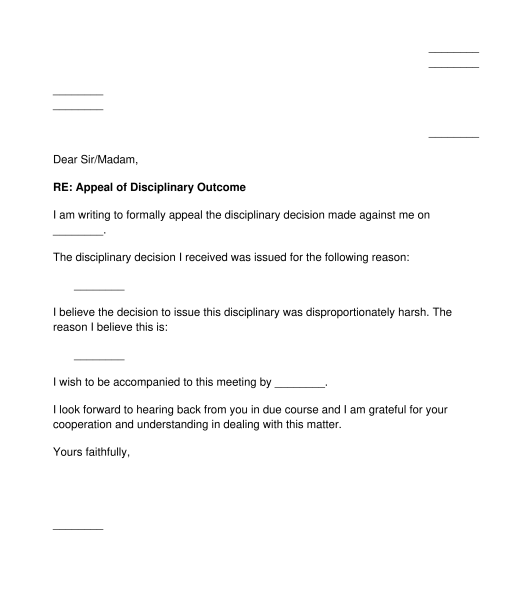 01/10/2025
01/10/2025

Answer a few questions and your document is created automatically.

Your document is ready! You will receive it in Word and PDF formats. You will be able to modify it.

 01/10/2025
01/10/2025
 Word and PDF
Word and PDF
 1 page
1 page
A disciplinary appeal letter is a letter used by an employee to appeal a disciplinary penalty made by an employer relating to the employee's performance at work. The disciplinary action taken by the employer could be suspending the employee from work, terminating their employment contract or other similar decisions. The employee can use this letter to request that the employer reconsider their decision or hold another disciplinary hearing to consider the matter again (e.g. where there are new facts or evidence that is relevant).
An example of an instance where this appeal letter can be used is where an employee has been given a disciplinary decision suspending them without pay as a result of their lateness. The employee can use this letter to explain that they have evidence showing they informed their supervisor about issues on their way to work, and also requested flexible working to accommodate their personal circumstances.
Yes, it may be mandatory to have a disciplinary appeal letter if the employer's disciplinary policy states that it is required when raising an appeal. A disciplinary appeal letter can be used to request that the employer's decision be overturned, reduced, reinvestigated or even suggest alternative resolution.
Even where the employer's policy does not provide for this, it is still highly recommended to have one as a means of documenting the employee's case in the event of escalation. A disciplinary appeal letter can be used to appeal a suspension with or without pay, a dismissal/termination of employment, a reduction in salary, a formal or informal warning given by the employer, or a disciplinary action for alleged misconduct.
Before a disciplinary appeal letter can be used, the employee should have already received a warning letter from the employer about a disciplinary action being taken against the employee in accordance with the employer's policy.
The disciplinary process followed by the employer should be in line with the ACAS code of conduct.
The employer should inform the employee in writing that they will be starting a disciplinary procedure. The letter or email should let the employee know the basis of the procedure and what the consequences of the disciplinary action may be (e.g. a warning letter, suspension etc).
After the employer has carried out a proper investigation, the employee should be invited to a meeting (i.e. the disciplinary hearing) where they should be given the opportunity to defend themselves. The employee may also exercise their legal right to be accompanied to the hearing.
After the hearing, the employer should take some time to consider all the evidences and arguments presented, and inform the employee of a decision as soon as possible (e.g suspension, termination, no punishment etc).
The parties involved are the employee, who is the sender of the disciplinary appeal letter, and the employer, who is the recipient. The recipient may also be a specific person within the employer's organisation (e.g. the HR Manager) who will receive and handle these types of matters within the employer's organisation.
There is no legal rule on when an employee should send their appeal to the employer. However, in practice, the appeal should be sent within a reasonable timeframe which is usually between 5 and 10 working days from the date of the disciplinary decision.
If the employer's disciplinary procedure states the timeline for when an appeal should be submitted, then the employee should follow the process outlined in the disciplinary procedure.
The completed letter should be signed and dated by the employee appealing against the disciplinary action.
It should then be provided to the appropriate individual within the employer's organisation who will be responsible for investigating the appeal (e.g. the HR Director) or in any other way stipulated in the employer's internal disciplinary procedure.
The employee appealing against the disciplinary action may wish to keep a copy of the document in case the employer loses or claims never to have received the original.
The employee can attach evidences to the letter to further support their appeal. These include:
No, the employer is not obligated to accept the reasons the employee presents in the appeal letter. However, they are required to properly and fairly consider them.
If the employer does not accept or ignores the employee's appeal without reasonable justifications, it may be treated as a failure to follow a fair process. If the employee ends up taking a claim to the employment tribunal, their case may be strengthened by the employer's failure to follow a fair process. Additionally, any compensation granted may be increased by up to 25% if the employer failed to follow ACAS guidelines.
If the employer fairly considered the appeal but still rejects the reasons, the employee can explore other internal options for further appeal if any exists, or raise a formal grievance under the employer's grievance procedure. The employee can also consider going for ACAS early conciliation and ultimately, the employee may raise a claim with the employment tribunal if they feel the employer's decision was legally unfair.
There are different types of disciplinary penalties, all depending on the particular offence and the employer's disciplinary procedure. These include:
In defending themselves in their appeal, an employee can challenge the disciplinary penalty on a variety of grounds, these include:
There are different behaviours that can give rise to a disciplinary penalty, such as:
A disciplinary appeal letter must contain:
LRA Code of Practice on Disciplinary and Grievance Procedures
UK Government Guidance on Dismissal
You fill out a form. The document is created before your eyes as you respond to the questions.
At the end, you receive it in Word and PDF formats. You can modify it and reuse it.
Guides to help you
Disciplinary Appeal Letter - Template - Word & PDF
Country: United Kingdom